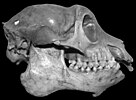Wikipedia:Today's featured article/November 2018
| << | Today's featured articles for November 2018 | >> | ||||
|---|---|---|---|---|---|---|
| Su | Mo | Tu | We | Th | Fr | Sa |
| 1 | 2 | 3 | ||||
| 4 | 5 | 6 | 7 | 8 | 9 | 10 |
| 11 | 12 | 13 | 14 | 15 | 16 | 17 |
| 18 | 19 | 20 | 21 | 22 | 23 | 24 |
| 25 | 26 | 27 | 28 | 29 | 30 | |
November 1
Interstate 75 in Michigan is a part of the Interstate Highway System that runs 396 miles (637 km) generally northward from Ohio to the Canadian border in Sault Ste. Marie. It passes near Lake Erie and through Detroit, Pontiac and Bay City, Michigan, crossing the Mackinac Bridge (pictured) in the Straits of Mackinac between Lake Michigan and Lake Huron. Within the state, the Interstate shares parts of its route with circle tours around four of the five Great Lakes, and spawns four auxiliary Interstates. Native American trails spanned the state along the general path of the modern freeway; after statehood, several of these were converted into plank roads that later became some of the first state highways. Interstate construction in Michigan started in 1957, signs went up in 1959, and the last section was opened on November 1, 1973. South of Michigan, Interstate 75 continues for 1,391 miles (2,239 km), terminating in Miami, Florida. (Full article...)
Part of the Interstate Highways in Michigan featured topic.
November 2
God of War: Ghost of Sparta is a third-person action-adventure video game for the PlayStation Portable, first released on November 2, 2010. Loosely based on Greek mythology, it is the sixth installment in the God of War series and the fourth chronologically. The player controls Kratos, a Spartan warrior who became the God of War. Haunted by visions of his mortal past, he journeys to the Domain of Death to rescue his brother Deimos, then teams up with him to battle the God of Death, Thanatos. The gameplay focuses on combo-based combat and includes quick time events that require the player to complete game controller actions in a timed sequence to defeat stronger enemies. The game also features magical attacks, puzzles, and platforming elements. Critics praised its story, gameplay, and graphics, and the game won awards at the 2010 Electronic Entertainment Expo and the 2010 Spike Video Game Awards. By June 2012, it had sold nearly 1.2 million copies worldwide. A remastered version was released for the PlayStation 3, included in the 2011 and 2012 God of War video game collections. (Full article...)
Part of the God of War franchise featured topic.
November 3
Bone Sharps, Cowboys, and Thunder Lizards (2005) is a graphic novel written by Jim Ottaviani and illustrated by the company Big Time Attic. It tells a slightly fictionalized account of the Bone Wars, a period of intense rivalry over the excavation of dinosaur fossils in the western United States. The novel is the first semi-fictional work written by Ottaviani; previously, he had taken no creative license with the characters he depicted, portraying them strictly according to historical sources. Bone Sharps follows two scientists, Othniel Charles Marsh and Edward Drinker Cope (pictured), as they pursue their hotheaded and sometimes illegal acquisitions of fossils. Along the way, they encounter P. T. Barnum, Buffalo Bill, Alexander Graham Bell, Ulysses S. Grant, and other figures of the Gilded Age. Upon release, the novel was praised by critics for its historical content. (Full article...)
November 4
The Eurasian tree sparrow (Passer montanus) is a bird in the sparrow family with a rich chestnut crown and nape, and a black patch on pure white cheeks on both sexes. It is widespread in the towns and cities of eastern Asia, but in Europe it is a bird of the lightly wooded open countryside. It is not closely related to the American tree sparrow. Its untidy nest is built within a natural cavity, a hole in a building, or the large nest of a Eurasian magpie or white stork. It feeds mainly on seeds, but invertebrates are also consumed, particularly during the breeding season. Parasites, diseases and birds of prey take their toll, and the typical life span is about two years. There have been large declines in western European populations, in part due to increased use of herbicides and a decline in winter stubble fields. The species has long been depicted in Chinese and Japanese art, and has appeared on the postage stamps of Antigua and Barbuda, Belarus, Belgium, Cambodia, the Central African Republic, China, Estonia, The Gambia and Taiwan. (Full article...)
November 5
Spiro Agnew was the 39th Vice President of the United States from 1969 until his resignation in 1973. A Republican, Agnew was born in Baltimore to a US-born mother and a Greek immigrant father. He became a lawyer, then held minor political offices before his election in 1962 as Baltimore County Executive. In 1966, he was unexpectedly elected Governor of Maryland, and was a surprise choice as Richard Nixon's running mate at the 1968 Republican National Convention. Initially regarded as a progressive, Agnew moved to the right after his election, appealing to conservatives who were wary of stances taken by Nixon, and also gained their applause for attacking the news media for bias. He had accepted kickbacks during his time in Maryland, and he was investigated for corruption in 1973. He pleaded no contest to tax evasion and resigned from office. Despite his fall he is regarded as a significant contributor to the Republican Party's move to the right. (Full article...)
November 6
The municipal election of November 6, 1951, in Philadelphia, Pennsylvania, produced the first Democratic victory in the city in more than a half-century. In the 1940s, Philadelphia had been the last major American city with nearly all of its political offices occupied by Republicans. The election was the first held under a reform charter that had been overwhelmingly approved by voters the previous April. Joseph S. Clark Jr. (pictured) and his running mate, Richardson Dilworth, were elected mayor and district attorney; they had been two of the main movers for the reform. Led by local party chairman James A. Finnegan, the Democrats also took fourteen of seventeen city council seats and all of the citywide offices on the ballot. A referendum on consolidating the city and county governments passed by a wide margin. The election marked the beginning of Democratic dominance of Philadelphia city politics, which continues today. (Full article...)
November 7
"Déjà Vu" is a song by American singer Beyoncé (pictured) that features vocals by rapper Jay-Z. It was produced by Rodney "Darkchild" Jerkins and Beyoncé for her second solo album, B'Day (2006). An R&B song, it incorporates elements of 1970s funk and soul music, with bass guitar, hi-hat, and French horns. In the lyrics, a woman is constantly reminded of a past lover. The song was released as the album's lead single to US radio stations in June 2006. It received mixed critical reviews, with favorable comparisons to Tina Turner's vocal performances of the 1980s. "Déjà Vu" was recognized as the Best Song of 2006 at the MOBO Awards, and a club remix by the Freemasons received three nominations for Best Remixed Recording, Non-Classical at the 2007 Grammy Awards. The song peaked at number four on the US Billboard Hot 100 chart, at number one on the UK Singles Chart, and generally within the top 20 in Europe. The accompanying music video was directed by Sophie Muller. (Full article...)
November 8
Nemegtomaia, a genus of feathered oviraptorid dinosaur, lived in what is now Mongolia during the Late Cretaceous, about 70 million years ago. The first specimen was found in the Nemegt Basin in 1996, and became the basis of the new genus and species N. barsboldi in 2004, honouring the palaeontologist Rinchen Barsbold. Two more specimens were found in 2007. Nemegtomaia is estimated to have been around 2 m (7 ft) in length and to have weighed 40 kg (88 lb). It had a deep, narrow, and short skull, with an arched crest. It was toothless, with a short snout, a parrot-like beak, and a pair of tooth-like projections on its palate. The first of its three fingers bore a strong claw. One specimen was found on top of a fossilised nest of eggs that were probably arranged in a ring, with streams nearby, judging from stratigraphic data. This individual may have been protecting its eggs by covering them with its tail and wing feathers. (Full article...)
November 9
Turning Point was a professional wrestling pay-per-view (PPV) event held on November 9, 2008, in Orlando, Florida, produced by the American Total Nonstop Action Wrestling (TNA) promotion. It was the fourth event in the Turning Point chronology and the eleventh in the 2008 TNA PPV schedule. Eight professional wrestling matches were featured on the event's card. In the main event, Sting defeated A.J. Styles to retain the TNA World Heavyweight Championship. Booker T (pictured earlier in 2008) fended off Christian Cage to retain the TNA Legends Championship. Kevin Nash bested Samoa Joe in a featured event, and Kurt Angle defeated Abyss in a Falls Count Anywhere match. Turning Point had an attendance of 1,100 people and, according to the Wrestling Observer Newsletter, a PPV audience of 30,000. Bryan and Chris Sokol of the professional wrestling section of the Canadian Online Explorer website rated the event 7 out of 10, up from the 2007 event's rating of 6.5. (Full article...)
November 10
Herman Vandenburg Ames (1865–1935) was an American legal historian, educator, and archivist. He was a professor of constitutional history at the University of Pennsylvania, and the dean of its graduate school for more than two decades. As a doctoral student at Harvard, he studied under the historian Albert Bushnell Hart. Like Hart, Ames spent time in Europe learning German historical methodology; drawing on his studies at the universities of Heidelberg and Leipzig, he later helped establish government archives throughout the United States. His 1897 monograph The Proposed Amendments to the Constitution of the United States During the First Century of Its History was the first exhaustive catalog of such amendments. He also authored John C. Calhoun and the Secession Movement of 1850 and Slavery and the Union 1845–1861, and coauthored The X.Y.Z. Letters. He has been credited with stimulating his student Ezra Pound's lifelong interest in history. (Full article...)
November 11
Mesopropithecus was a lemur from Madagascar, slightly larger than any of those alive today, but one of the smallest that are known only from subfossil remains. This genus of the sloth lemur family Palaeopropithecidae includes the species M. dolichobrachion, M. globiceps, and M. pithecoides. All three species were primarily leaf-eaters, but also ate fruit and seeds. M. globiceps ate more seeds than M. pithecoides, and an analysis of the teeth of M. dolichobrachion suggests that it ate even more seeds; it also had distinctly longer arms. A recently discovered postcranial skeleton shows that Mesopropithecus had longer forelimbs than hindlimbs—a trait shared by all sloth lemurs. Remains of M. dolichobrachion have been found only in the north of the island, M. pithecoides in the south and west, and M. globiceps in the center. The genus died out after the arrival of humans on the island, probably through hunting, habitat destruction, or both. (Full article...)
November 12
Archie vs. Predator is a comic book series written by Alex de Campi (pictured) of Dark Horse Comics and drawn by Fernando Ruiz of Archie Comics. It features Predator, a deadly alien trophy hunter, who stalks the clean-cut teenager Archie Andrews and his high school classmates, until the survivors realize they are being hunted and fight back. A four-issue limited series was released in the US in 2015 between April and July, and a hardcover collection went on sale in November. Archie Comics proposed the idea to Dark Horse, which holds the license to comics featuring 20th Century Fox's Predator. The series received positive reviews from critics, who enjoyed the strange matchup and dark humor. The April issue was the top seller for both publishers, and garnered an average review rating of 7.9 out of 10 according to the review aggregator Comic Book Roundup. The series won a Ghastly Award for Best Limited Series. (Full article...)
November 13
Imleria badia, the bay bolete, is an edible, pored mushroom found in Europe and North America, growing in coniferous or mixed woods on the ground or on decaying tree stumps. Both the common and scientific names refer to the bay-coloured cap, which is almost spherical in young specimens before broadening and flattening out to 15 cm (6 in) or more in diameter. On the cap's underside are small yellowish pores that bruise dull blue-grey when injured. The smooth, cylindrical stalk, measuring 4–9 cm (1.6–3.5 in) long by 1–2 cm (0.4–0.8 in) thick, is coloured like the cap, but paler. Regarded as a choice edible mushroom by some food writers, such as Antonio Carluccio, it is sold in markets in Europe and central Mexico. The mushroom can bioaccumulate mercury, cobalt, nickel and other metals; radioactive caesium levels spiked in specimens collected in Europe following the 1986 Chernobyl disaster. (Full article...)
November 14
Muhammad I (1195–1273) was the first ruler of the Emirate of Granada, the last independent Muslim state on the Iberian Peninsula. In the 1230s he took power in his native Arjona and gained control over Spain's southern cities, including Granada, Almería and Málaga. Settling in Granada, he became the most powerful Muslim leader in the peninsula. Under attack from Castile, he was forced to become a vassal of Ferdinand III in 1246. A peace with Castile followed until 1264 when Muhammad participated in an unsuccessful rebellion of their newly conquered Muslim subjects. In 1266 his former allies, the Banu Ashqilula, rebelled against him with help from Castile. This conflict was still unresolved in 1273 when he died after falling off his horse. The emirate was finally annexed by Castile in 1492. The Alhambra, a well-preserved palace and fortress complex that Muhammad initiated, is a World Heritage Site. (Full article...)
November 15
Portrait of Maria Portinari (c. 1470–72) is a small tempera and oil-on-wood painting by Hans Memling. It portrays Maria Maddalena Baroncelli, about whom very little is known. Around 14 years old, she is depicted shortly before her wedding to the Italian banker Tommaso Portinari, who was an intimate of Charles the Bold and manager of the Bruges branch of a bank controlled by Lorenzo de' Medici. Maria is dressed in the height of late 15th-century fashion, with an elaborate jewel-studded necklace and a long black hennin with a transparent veil. Her headdress is similar and necklace identical to those in her depiction in Hugo van der Goes's Portinari Altarpiece (c. 1475), a painting that may have been partly based on Memling's portrait. The panel is the right wing of a hinged devotional triptych; the lost center panel is recorded in 16th-century inventories as a Virgin and Child. Maria and Tommaso's portraits are hung alongside each other at the Metropolitan Museum of Art in New York. (Full article...)
November 16
Since 1980, York City F.C., a professional association football club based in York, North Yorkshire, England, has seen many promotions and relegations. The team won its only English Football League title after finishing first in the Fourth Division in 1983–84 with 101 points, the most season points scored by any team at the time. After four seasons in the Third Division, they were relegated in 1987–88. They beat Crewe Alexandra at Wembley Stadium in the play-off final in 1992–93, winning promotion to the renamed Second Division. Later in the 1990s, they knocked Premier League teams Manchester United and Everton out of the League Cup in successive seasons. At the end of 2003–04, they lost their Football League status. The 2011–12 FA Trophy (celebration pictured) was the first national knockout competition won by York, and they returned to the Football League that season. (Full article...)
Part of the York City F.C. featured topic.
November 17
Nihonium is a synthetic chemical element with symbol Nh and atomic number 113. It is extremely radioactive; its most stable known isotope, nihonium-286, has a half-life of about 10 seconds. In the periodic table, nihonium is a transactinide element at the intersection of period 7 and group 13. Its creation was reported in 2003 by a Russian–American collaboration at the Joint Institute for Nuclear Research in Dubna, Russia, and in 2004 by a team of Japanese scientists at Riken in Wakō, Japan. The discoveries were confirmed by independent teams working in the United States, Germany, Sweden, and China. In 2015 the element was officially recognised; naming rights were assigned to Riken, as they were judged to have been first to confirm their discovery. The name, approved in the same year (announcement pictured), derives from a Japanese word for Japan, Nihon. Few details are known about nihonium, as it has only been formed in very small amounts that decay away within seconds. (Full article...)
November 18
The Rhode Island Tercentenary half dollar is a commemorative fifty-cent piece, struck by the United States Bureau of the Mint in 1936. The coin was designed by John Howard Benson and Arthur Graham Carey. Its obverse (pictured) depicts Roger Williams, founder of the Colony of Rhode Island and Providence Plantations, meeting a Native American. It was intended to honor the 300th anniversary of Providence, Rhode Island, although it bears no mention of the city. A total of 50,000 coins were struck at the three mints then in operation. On March 5, 1936, Rhode Island banks holding the coins announced that the entire issue had sold out within six hours, but ample supplies proved to be available at higher prices from insiders. Coin collectors were incensed, and the abuses led Congress to end the authorization for outstanding commemorative coin issues in 1939. Today the half dollars list for hundreds of dollars, depending on condition. (Full article...)
November 19
Life's Shop Window is an American silent drama film directed by J. Gordon Edwards, released on November 19, 1914. Starring Claire Whitney and Stuart Holmes, it is a film adaptation of the 1907 novel by Annie Sophie Cory. It depicts the story of English orphan Lydia Wilton (Whitney) and her husband Bernard Chetwin (Holmes). Although Wilton's marriage is legitimate, it was conducted in secret, and she is accused of having a child out of wedlock. Forced to leave England, she reunites with her husband in Arizona. There, she meets an old acquaintance, Eustace Pelham, and considers running away with him before she sees the error of her ways and returns to her family. Life's Shop Window was the first film produced, rather than simply distributed, by William Fox's Box Office Attractions Company, the corporate predecessor to Fox Film. Reviewers' opinions of the film's quality were mixed, but it was very popular upon its initial release in New York. Like many of Fox's early works, it was likely lost in the 1937 Fox vault fire. (Full article...)
November 20
Connie Talbot (born 20 November 2000) is a British singer who reached the final of the first series of Britain's Got Talent in 2007. Although she had never taken singing lessons, her initial performance drew international press coverage. She signed with Rainbow Recording Company, and her debut album, Over the Rainbow, was released in the UK in November 2007. The album was re-released in June 2008 with a new track listing, along with its first single, a cover of Bob Marley's "Three Little Birds". Over the Rainbow reached number one in three countries, and has sold over 250,000 copies worldwide. Since the initial album release, Talbot has performed publicly and on television in Europe and the US, as well as across Asia, where her music had gained recognition through YouTube. Three more albums by Talbot were released between 2008 and 2012: Connie Talbot's Christmas Album, Holiday Magic and Beautiful World. (Full article...)
November 21
Hurricane Irene was a long-lived tropical cyclone of the 2005 Atlantic hurricane season. After forming near Cape Verde on August 4, it crossed the Atlantic, turned northward near Bermuda, and was absorbed by an extratropical cyclone southeast of Newfoundland. Irene persisted for 14 days as a tropical system, longer than any other storm of the 2005 season. It was the ninth named storm and fourth hurricane of what became the most active Atlantic hurricane season since record-keeping began. Irene proved to be a difficult storm to forecast due to oscillations in strength. After almost dissipating on August 10, it peaked as a Category 2 hurricane on August 16. Because of uncertainty in predicting the storm's track, there were initial fears of a landfall in the United States, but Irene never approached land and caused no recorded damage. One person died in Long Beach, New York, from swells up to 8 feet (2.4 m) and strong rip currents. (Full article...)
November 22
"Triangle" is the third episode of the sixth season of the American science fiction television series The X-Files. Written and directed by series creator Chris Carter (pictured), it premiered on the Fox network on November 22, 1998, with 18.20 million viewers. In this episode, FBI special agent Fox Mulder (David Duchovny), who works on cases linked to the paranormal along with Dana Scully (Gillian Anderson), boards a passenger liner in the Bermuda Triangle. Transported back in time to the outbreak of World War II, he encounters German soldiers searching for a superweapon called Thor's Hammer. Main and recurring cast members, including Anderson, William B. Davis, Chris Owens, James Pickens Jr. and Mitch Pileggi, play additional characters aboard the ship, distinct from their regular characters. Inspired by the 1948 Alfred Hitchcock film Rope, many scenes were edited to appear as single takes. The episode received generally positive reviews. (Full article...)
November 23
Nico Ditch is a six-mile-long (9.7 km) linear earthwork between Ashton-under-Lyne and Stretford in Greater Manchester, England. It was dug as a defensive fortification, or possibly a boundary marker, between the 5th and 11th centuries. The earliest documented reference to the ditch is in a charter detailing the granting of land in Audenshaw to the monks of the Kersal Cell. In the document, dating from 1190 to 1212, the earthwork is referred to as "Mykelldiche", and a magnum fossatum, Latin for "large ditch". Despite heavy weathering, it is still visible in short sections, which can be 4–5 yards (3.7–4.6 m) wide and up to 5 feet (1.5 m) deep. A 330-yard (300 m) stretch through Denton Golf Course and a section running through Platt Fields Park are considered the best-preserved remains. In 1997, a segment of the ditch in Platt Fields was protected as a Scheduled Ancient Monument. The rest of the ditch remains unprotected. (Full article...)
November 24
The SECR N class was a steam locomotive designed by Richard Maunsell for mixed-traffic duties on the South Eastern and Chatham Railway (SECR) in London and south-east England. This locomotive class, with two leading wheels and no trailing wheels (2-6-0), was mechanically similar to the SECR K class 2-6-4 passenger tank engine, also by Maunsell. Built at Ashford Works and the Royal Arsenal, Woolwich, between 1917 and 1934, the N class was based on the GWR 4300 Class design, improved with Midland Railway concepts. The class replaced obsolete 0-6-0s as part of the SECR's fleet standardisation, using parts interchangeable with those of other classes. Eighty N class locomotives were built in three batches between the First and Second World Wars. They worked over most of the Southern Railway network, and were used by the Southern Region of British Railways until the last was withdrawn in 1966. One locomotive is preserved on the Swanage Railway in Dorset, undergoing overhaul. (Full article...)
November 25
Wiglaf ruled the Anglo-Saxon kingdom of Mercia from 827 to 829 and again from 830 until his death in 839. His ancestry is uncertain: the 820s were a period of dynastic conflict within Mercia, and the genealogies of several of the kings of this time are unknown. He succeeded Ludeca, who was killed campaigning against East Anglia. Wiglaf's first reign coincided with the continued rise of the rival kingdom of Wessex under Ecgberht. Ecgberht drove Wiglaf from the throne in 829, and ruled Mercia directly for a year. Mercia never regained the south-eastern kingdoms, but Berkshire and perhaps Essex came back into Mercia's control. Although Wiglaf appears to have restored independence, the recovery was short-lived, and later in the century Mercia was divided between Wessex and the Vikings. Wiglaf died in about 839, and was eventually succeeded by Beorhtwulf, though one tradition records his son Wigmund as having reigned briefly. Wiglaf is buried at Repton, near Derby (engraving of the crypt pictured). (Full article...)
November 26
Grasshoppers are insects in the suborder Caelifera, probably the oldest living group of chewing herbivorous insects, dating back to the early Triassic around 250 million years ago. They are typically ground-dwelling insects with powerful hind legs which enable them to escape from threats by leaping vigorously. Defences against their many predators include camouflage, flight, and brilliantly coloured wing-flashes that can startle or distract an assailant. Some species have warning coloration. Grasshoppers share the order Orthoptera with crickets in the other suborder Ensifera. Some grasshopper species can change colour and behaviour to form locust swarms that can destroy crops and cause famine over wide areas. Even in smaller numbers, the insects can be serious pests. They are used as food in some countries, including Mexico and Indonesia. They feature in art, symbolism and literature. (Full article...)
November 27
Are You Experienced is the debut studio album by English-American rock band the Jimi Hendrix Experience (pictured). Released in 1967, the LP was an immediate critical and commercial success, and it is widely regarded as one of the greatest debuts in the history of rock music. Featuring Jimi Hendrix's songwriting and electric guitar playing, the album established a new direction in psychedelic and hard rock music. Are You Experienced and its preceding singles were recorded between late October 1966 and early April 1967. Released in the UK in May, the album spent 33 weeks on the charts, peaking at number two. The US release, issued in August, contained some of Hendrix's best-known songs, including the Experience's first three singles: "Purple Haze", "Hey Joe", and "The Wind Cries Mary". Both the US and UK versions included "Foxy Lady". In 2005, Rolling Stone ranked Are You Experienced 15th on its list of the 500 Greatest Albums of All Time. (Full article...)
November 28
Bulgaria is a country in Southeastern Europe. It borders Romania to the north, Serbia and the Republic of Macedonia to the west, Greece and Turkey to the south, and the Black Sea to the east. The semi-nomadic Bulgars founded the first Bulgarian state in AD 681, which was instrumental in the development and spread of the Cyrillic script. The modern Bulgarian state was established following the Russo-Turkish War of 1877–78 and obtained full independence in 1908. It transformed into a Soviet-allied people's republic in 1946, but the fall of communism paved the way for a transition into a parliamentary democracy in 1990. Since joining the European Union in 2007, Bulgaria has improved its Human Development Index. The country has an open market economy focused on services. The biggest cities are Sofia (the capital), Plovdiv, Varna and Burgas. The population, currently around seven million, has declined significantly since 1988. (Full article...)
November 29
New York State Route 308 is a 6.19-mile-long (9.96 km) state highway within northern Dutchess County in New York State that connects U.S. Route 9 and NY 9G. The western end of the highway is in the Rhinebeck Village Historic District, a 2.6-square-mile (6.7 km2) area that features 272 buildings in a variety of architectural styles. NY 308 passes near the Dutchess County Fairgrounds, several historical landmarks, and the Landsman Kill River, a minor tributary of the Hudson River. Around 1685, the Native American Sepasco Trail ran from the Hudson eastward through modern-day Rhinebeck and ended at Lake Sepasco, roughly following NY 308 and its side roads. The trail remained until 1802, when part of the Ulster and Delaware Turnpike was chartered over it, extending from Salisbury, Connecticut, to the Susquehanna River at or near the town of Jericho (now Bainbridge). NY 308 incorporates a portion of the former turnpike. (Full article...)
November 30
The Battle of Tassafaronga was fought on the night of November 30, 1942, between US Navy and Imperial Japanese Navy warships near Tassafaronga Point on the Pacific island of Guadalcanal. Five cruisers and four destroyers under the command of Rear Admiral Carleton H. Wright (pictured) stalked eight Japanese destroyers under Rear Admiral Raizō Tanaka that were en route to deliver food to their forces on the island. Using radar, the US warships gained surprise, opened fire, and sank one of the destroyers. Tanaka's ships reacted quickly, launching Type 93 "Long Lance" torpedoes that sank one US cruiser and heavily damaged three others. The rest of Tanaka's force escaped without significant additional damage, abandoning the intended supply mission. The battle had little strategic impact, and the Japanese were unable to recapture Guadalcanal from Allied forces. (Full article...)
Part of the Guadalcanal Campaign featured topic.





























